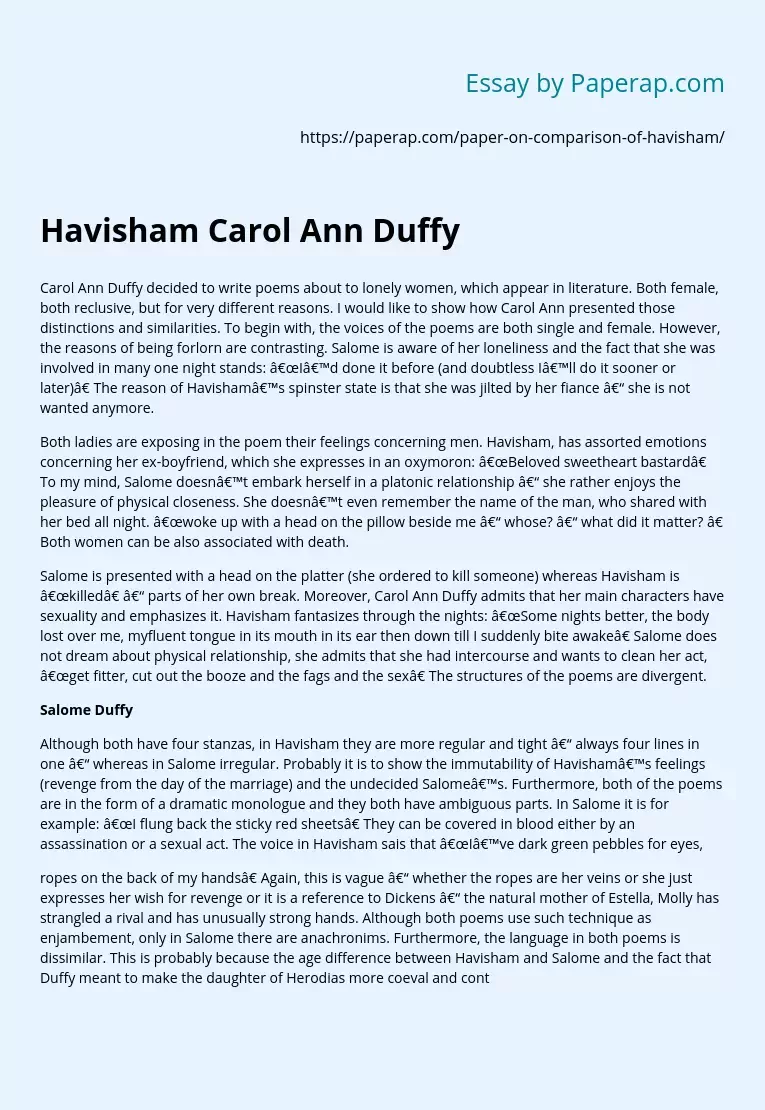Havisham Carol Ann Duffy
Carol Ann Duffy decided to write poems about lonely women, which appear in the literature. Both female, both reclusive, but for very different reasons. I would like to show how Carol Ann presented those distinctions and similarities. To begin with, the voices of the poems are both single and female. However, the reasons of being forlorn are contrasting. Salome is aware of her loneliness and the fact that she was involved in many one nights stands: “I’d done it before (and doubtless I’ll do it sooner or later)” The reason for Havisham’s spinster state is that she was jilted by her fiance – she is not wanted anymore.
Both ladies are exposing in the poem their feelings concerning men. Havisham has assorted emotions concerning her ex-boyfriend, which she expresses in an oxymoron: “Beloved sweetheart bastard” To my mind, Salome doesn’t embark herself in a platonic relationship – she rather enjoys the pleasure of physical closeness. She doesn’t even remember the name of the man, who shared with her bed all night.
“woke up with a head on the pillow beside me – whose? – what did it matter? ” Both women can be also associated with death.
Salome is presented with a head on the platter (she ordered to kill someone) whereas Havisham is “killed” – parts of her own break. Moreover, Carol Ann Duffy admits that her main characters have sexuality and emphasizes it. Havisham fantasizes through the nights: “Some nights better, the body lost over me, my fluent tongue in its mouth in its ear then down till I suddenly bite awake” Salome does not dream about physical relationship, she admits that she had intercourse and wants to clean her act, “get fitter, cut out the booze and the fags and the sex” The structures of the poems are divergent.
Although both have four stanzas, in Havisham they are more regular and tight – always four lines in one – whereas in Salome irregular. Probably it is to show the immutability of Havisham’s feelings (revenge from the day of the marriage) and the undecided Salome’s. Furthermore, both of the poems are in the form of a dramatic monologue and they both have ambiguous parts. In Salome it is for example: “I flung back the sticky red sheets” They can be covered in blood either by assassination or a sexual act. The voice in Havisham said that “I’ve dark green pebbles for eyes,
ropes on the back of my hands” Again, this is vague – whether the ropes are her veins or she just expresses her wish for revenge or it is a reference to Dickens – the natural mother of Estella, Molly has strangled a rival and has unusually strong hands. Although both poems use such technique as enjambement, only in Salome there are anachronisms. Furthermore, the language in both poems is dissimilar. This is probably because of the age difference between Havisham and Salome and the fact that Duffy meant to make the daughter of Herodias more coeval and contemporary.
As a result, Salome uses slang as “and ain’t life a bitch” whereas Havisham uses less informal words as “pebbles”, “corpse”. As a result, the tone in Salome is much more relaxed and in Havisham more disturbing. Carol Ann Duffy also uses rhyme only in Salome in order to build tense leading to the final conclusion. One of the most significant similarities in both poems is that they both use the idea of subversion. The character of Salome appeared in the New Testament books of Matthew and Mark. Miss Havisham was originally invented by Charles Dickens and presented in “Great Expectations”.
Duffy took both characters and presented them in a deeper, unconventional way. She showed the layer of the human being, which was a taboo, and widened it. To sum up, the whole purpose of poems entitled “Salome” and “Havisham” is to present much deeper the soul and the attitudes of those females concerning men. The whole text is subordinated to this aim – language, structure present their characters. That is why the main differences between those poems will come from the dissimilarity of personality. As a result, those contradictions will be reflected in any other parts of the poem.
Havisham Carol Ann Duffy. (2019, Dec 05). Retrieved from https://paperap.com/paper-on-comparison-of-havisham/

